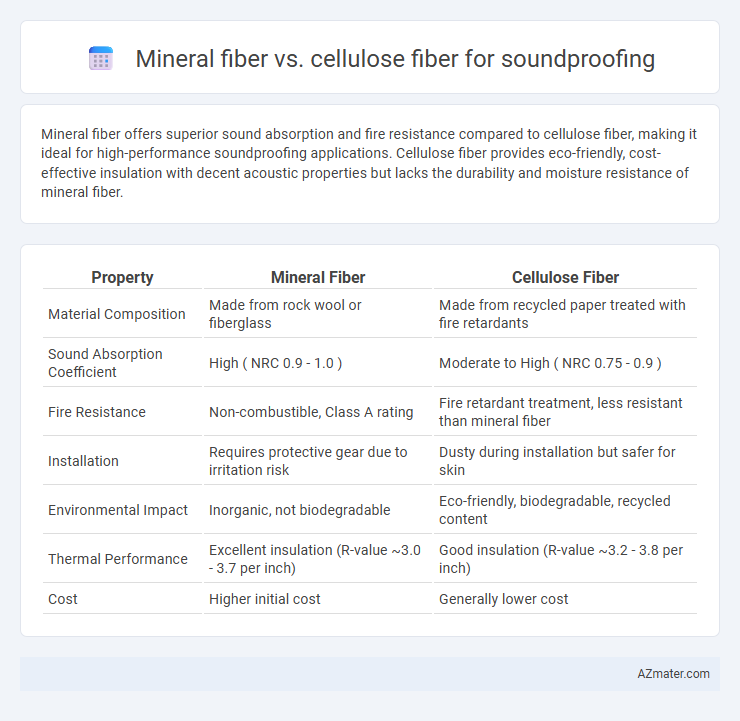Mineral fiber offers superior sound absorption and fire resistance compared to cellulose fiber, making it ideal for high-performance soundproofing applications. Cellulose fiber provides eco-friendly, cost-effective insulation with decent acoustic properties but lacks the durability and moisture resistance of mineral fiber.
Table of Comparison
| Property | Mineral Fiber | Cellulose Fiber |
|---|---|---|
| Material Composition | Made from rock wool or fiberglass | Made from recycled paper treated with fire retardants |
| Sound Absorption Coefficient | High ( NRC 0.9 - 1.0 ) | Moderate to High ( NRC 0.75 - 0.9 ) |
| Fire Resistance | Non-combustible, Class A rating | Fire retardant treatment, less resistant than mineral fiber |
| Installation | Requires protective gear due to irritation risk | Dusty during installation but safer for skin |
| Environmental Impact | Inorganic, not biodegradable | Eco-friendly, biodegradable, recycled content |
| Thermal Performance | Excellent insulation (R-value ~3.0 - 3.7 per inch) | Good insulation (R-value ~3.2 - 3.8 per inch) |
| Cost | Higher initial cost | Generally lower cost |
Introduction to Soundproofing Materials
Mineral fiber and cellulose fiber are common soundproofing materials designed to reduce noise transmission by absorbing sound waves within walls, ceilings, and floors. Mineral fiber, typically made from rock or slag, offers excellent thermal insulation, fire resistance, and high sound absorption coefficients, making it ideal for industrial and residential applications. Cellulose fiber, derived from recycled paper treated with fire retardants, provides eco-friendly soundproofing with effective noise dampening properties and moisture resistance in building cavities.
What Are Mineral Fibers?
Mineral fibers, commonly used in soundproofing, are inorganic fibers derived from natural or synthetic sources like rock wool, slag wool, and glass wool, known for their high density and excellent sound absorption properties. These fibers effectively reduce noise transmission by trapping sound waves within their fibrous structure, making them ideal for insulation in walls, ceilings, and floors. Compared to cellulose fiber, mineral fibers offer better fire resistance and moisture resistance, enhancing durability in soundproofing applications.
What Are Cellulose Fibers?
Cellulose fibers, primarily made from recycled paper products treated with fire retardants, offer excellent sound absorption properties for soundproofing applications by reducing airborne noise inside walls and ceilings. Unlike mineral fibers such as fiberglass and rock wool, cellulose fibers have a denser composition that effectively dampens sound vibrations, improving acoustic performance in residential and commercial buildings. Their eco-friendly nature, combined with thermal insulation benefits, makes cellulose fibers a sustainable choice for soundproofing compared to mineral fiber options.
Acoustic Performance Comparison
Mineral fiber offers superior sound absorption due to its dense, fibrous structure that effectively traps airborne noise and reduces sound transmission through walls and ceilings. Cellulose fiber provides good acoustic dampening by filling gaps and reducing thermal conductivity, but it generally performs slightly lower in noise reduction coefficients compared to mineral fiber. Acoustic performance tests show mineral fiber insulation achieving higher sound transmission class (STC) ratings, making it a preferred choice for rigorous soundproofing applications.
Installation Process and Ease
Mineral fiber insulation, such as rock wool or fiberglass, typically requires protective gear during installation to avoid skin irritation and respiratory issues, and it can be cut to fit irregular spaces more easily than cellulose. Cellulose fiber, derived from recycled paper, is often blown in, which allows for rapid coverage of existing cavities with minimal labor but requires specialized equipment for proper installation. Both materials offer effective soundproofing qualities, but mineral fiber's rigid batts provide more straightforward handling in new constructions, whereas cellulose excels in retrofitting due to its dense, seamless fill.
Cost Efficiency Analysis
Mineral fiber insulation, such as fiberglass and rock wool, offers high sound absorption at a moderate cost, making it a cost-efficient choice for residential and commercial soundproofing projects. Cellulose fiber, derived from recycled paper products, provides effective sound dampening with lower initial costs and higher environmental benefits but may require additional treatments for fire and moisture resistance. Evaluating long-term durability and maintenance expenses reveals mineral fiber as more cost-efficient in high-moisture or high-heat environments, while cellulose is advantageous for budget-conscious, eco-friendly installations.
Fire Resistance Capabilities
Mineral fiber insulation, typically made from rock or slag, offers superior fire resistance due to its non-combustible nature and ability to withstand temperatures exceeding 1000degF, making it ideal for enhancing fire safety in soundproofing applications. Cellulose fiber, derived from recycled paper treated with fire retardants, provides moderate fire resistance but can be less effective under prolonged high heat exposure compared to mineral fiber. Choosing mineral fiber over cellulose fiber improves both soundproofing and fire protection in residential and commercial building projects.
Moisture and Mold Resistance
Mineral fiber offers superior moisture resistance compared to cellulose fiber, reducing the risk of mold growth in soundproofing applications. Its inorganic composition prevents water absorption, maintaining its insulating properties even in humid environments. Cellulose fiber, derived from plant materials, is more susceptible to moisture retention and consequently mold, which can degrade both its acoustic and structural performance over time.
Environmental Impact and Sustainability
Mineral fiber, often made from recycled glass or rock, offers effective soundproofing with moderate environmental impact due to energy-intensive production processes and limited biodegradability. Cellulose fiber, primarily composed of recycled paper treated with fire retardants, provides sustainable soundproofing by utilizing renewable materials and exhibiting high recyclability and biodegradability. Choosing cellulose fiber enhances eco-friendly building practices by reducing landfill waste and lowering embodied carbon compared to mineral fiber alternatives.
Choosing the Right Fiber for Your Soundproofing Needs
Mineral fiber, made from rock or slag, offers superior density and thermal resistance, making it highly effective for soundproofing walls and ceilings in commercial and industrial spaces. Cellulose fiber, derived from recycled paper treated with fire retardants, provides excellent eco-friendly acoustic insulation, ideal for residential applications seeking sustainable solutions. Assess specific soundproofing requirements, fire safety standards, and environmental impact before selecting the appropriate fiber to ensure optimal noise reduction and energy efficiency.

Infographic: Mineral fiber vs Cellulose fiber for Soundproofing
 azmater.com
azmater.com